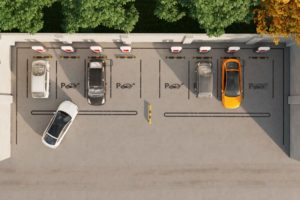Quick Navigation
Parking on curbs is common in cities and towns across the United States. However, there are rules and regulations in place governing the right way to park on a curb.

These rules vary by city and state, and drivers need to familiarize themselves with the specific laws in their area to avoid getting ticketed or towed.
In this article, we will talk through all you need to know about the parking on curbs rule in the US to help you understand and avoid trouble parking your car, such as getting ticketed or towed.
Keep reading!
What are the Parking Curb Rules in the US?
As a responsible driver, you should prioritize safety for your benefit and the sake of others.
One way to demonstrate courteousness and consideration is by following proper parking curb rules.
Here are some important guidelines to remember when parking your vehicle on the curb.
1. Red Curb
Parking is generally not allowed at a red curb. Red curbs often indicate fire lanes, which are meant to be kept clear for emergency vehicles.
Red curbs also mark areas where parking is not allowed for other reasons, like in front of hospitals or intersections.
Or near a fire hydrant, you can’t park or block the fire hydrant in case an emergency fire happens.
It usually means “NO STOPPING,” “NO STANDING,” or “NO PARKING” zone in conjunction with the appropriate signs.
However, buses can stop quickly on the red curb as long as it is marked, but if not, they should not stop to avoid getting ticketed or towed.
It is important to observe red curbs to ensure that emergency vehicles can get through.
2. Yellow Curb
Parking is only allowed for a limited time at a yellow curb, typically for loading and unloading purposes.
Usually, time limits are indicated by a sign posted nearby. Yellow curbs are often used in commercial areas where deliveries generally occur.
However, drivers should stay in their vehicles to move faster when needed.
Pay attention to the time limits indicated on nearby signs to avoid getting a ticket or having your vehicle towed.
3. Green Curb
Parking is usually allowed at a green curb, although there may be time limits or other restrictions indicated by nearby signs.
Green curbs are often used in areas where parking is generally allowed but are subject to certain conditions, such as time limits of 15-30 minutes only.
Usually, green curbs are used for the loading zone of students if appropriate signs accompany them.
This rule is true for many states; however, it does not mean universal. Like in New Jersey, green curbs mean the parking is reserved for car-sharing vehicles.
4. White Curb

Parking is generally allowed at a white curb, although there may be time limits or other restrictions indicated by nearby signs.
White curbs are often used in residential areas where parking is allowed but subject to certain conditions.
Drivers can stop long enough to pick up or drop off passengers or mail but can only park for a short time.
5. Blue Curb
Parking is usually allowed at a blue curb, but only for people with disabilities who have a special permit or license plate.
Blue curbs are reserved for people with disabilities to ensure easy access to buildings and other facilities.
Or someone who is driving a disabled person can park on a blue curb.
It is a public street where a disabled driver can park anytime, while the space next to the disabled parking space painted with blue diagonal stripes is not allowed for any vehicle.
It is intended for van ramps for disabled drivers.
6. No Color Curb
No color curbs are usually treated the same as white curbs where drivers can park but for a limited time only.
Observing these curbs and only parking in designated spaces if you have the proper permit is essential.
How To Park with Curb?
Here’s how you park your car with the curb:
If You Park Your Car on a Hill:
- To ensure the safety of your vehicle while it is parked, make sure to put it in “park” (for automatic transmissions) or low gear (for manual transmissions).
- Additionally, be sure to engage the parking brake.
- If your brakes fail, positioning the front wheels towards the curb or side of the road will allow you to roll the car away from traffic.
If You Park Your Car Facing Downhill:
- To prevent your car from rolling in traffic, turn your front wheels on the curb or the roadside. It will make your vehicle move on the curb and stop, then roll away into the traffic flow.
If You Park Your Car Facing Uphill:
- If you park on the street with a curb, turn your front wheels in the curb, it will prevent your vehicle from rolling into the traffic flow if your brakes fail.
- On the other hand, if you park on the street without a curb, turn your front wheels away to allow the car to roll towards the curb, not on the traffic.
Why is Parking Curb Important in the US?
Parking curbs are essential in the United States for several reasons:
- They help to regulate and control parking in crowded urban areas. Using different colors of curbs to indicate different parking rules and regulations makes it easier for drivers to know where they can and cannot park.
- They help to ensure the safety of pedestrians and drivers. For example, red curbs mark fire lanes, which are meant to be kept clear for emergency vehicles. By not parking in these areas, drivers can help ensure that emergency vehicles can quickly respond to emergencies.
- They help to keep roads and sidewalks clear and free of obstructions. By not parking in inappropriate areas or in a way that obstructs traffic or pedestrian walkways, drivers can help to keep roads and sidewalks safe and accessible for all users.
Do’s and Don’ts of Parking Curb in the US

Here are some general do’s and don’ts of parking at curbs in the United States:
Dos:
- Observe all parking signs and regulations. It includes paying attention to the color of the curb, time limits, and any other restrictions indicated on nearby signs.
- Park in designated parking spaces. It includes using parking garages or lots if they are available.
- Make sure your vehicle is entirely within the lines of the parking space.
- Use your hazard lights when necessary, such as when loading or unloading heavy items from your vehicle.
Don’ts:
- Park in a way that obstructs traffic or interferes with the flow of vehicles.
- Park at a red curb, as this is generally not allowed.
- Park at a yellow curb for longer than the time limit indicated on the nearby sign.
- Park in a designated space for people with disabilities unless you have the proper permit.
To Sum Up
Parking on the curb can be a convenient option in some situations, but it is important to be aware of the specific rules and regulations that apply to curb parking in your area.
Some general rules to keep in mind include avoiding parking in front of a driveway, fire hydrant, or crosswalk, not blocking the flow of traffic, and observing any painted curb markings or signs that indicate parking restrictions.
By following these rules and using common sense, you can help to ensure the safety of yourself, other drivers, and pedestrians and avoid getting ticketed or towed.

With comprehensive experience in writing exceptional quality articles and blogs about cars and related stuff, Daniel is one of the finest bloggers and a hardcore car lover we have. He is an ASE certified technician with an across-the-board experience of 10 years in the industry. He could not help tinkering with anything he got his hands on from a young age, which led to his remarkable career in the automotive repair industry.
When he is not under any hood, you can find him on the water or in the woods to pursue his passion for hunting and fishing. He has been writing for multiple sectors and is a regular contributor to several publications.
He currently owns a Nissan 300ZX TT and a Pearl Yellow but plans to upgrade it to 550 HP. His favorites include the Koenigsegg CCX and Lamborghini Diablo 6.0 VT, but for him, the Ferrari 360 Spider is one of the sexiest cars that exists to date.
Being an avid world traveler, he has spent most of his time analyzing the automotive markets, latest technology, and local favorites to enhance his knowledge base. He is currently living in North Caroline, where it’s all about food and coffee and, of course, cars.



